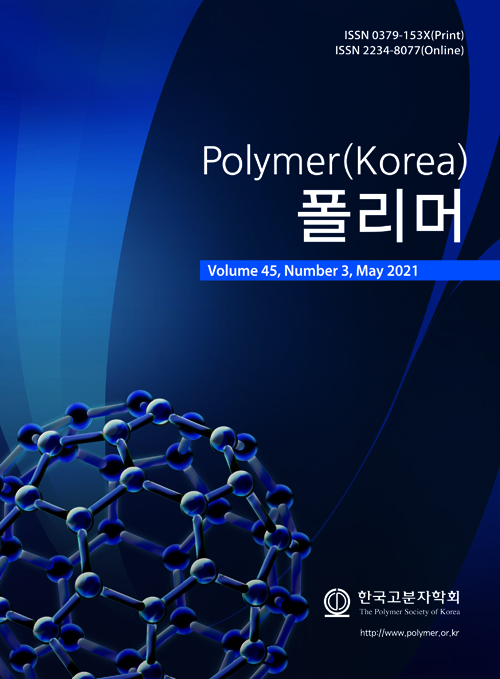- Biopolyurethane Foam Polymerized with Inherent Microcrystalline Cellulose (MCC)-deficient Polyol Obtained from Liquefaction of a Lignocellulosic Biomass and Isocyanate, and Its Characterization
Department of Chemical Engineering, Daegu University, Gyeongbuk 38453, Korea
- 고유 Microcrystalline Cellulose를 제거한 리그노셀루로식 바이오매스 액화 폴리올을 성분으로 한 바이오 폴리우레탄 폼의 특성
대구대학교 공과대학 화학공학과
Reproduction, stored in a retrieval system, or transmitted in any form of any part of this publication is permitted only by written permission from the Polymer Society of Korea.
Bio-polyurethane (PU) foams were prepared, using inherent residue-deficient lignocellulosic polyol liquefied from biomass (sawdust, larix kaempferi) (liquefied polyol A) or both inherent microcrystalline cellulose (MCC) and inherent residue-deficient lignocellulosic polyol liquefied from the same (liquefied polyol B), according to the optimal condition and the process condition showing the maximized average size of bio-PU foam cells, suggested in the previous study of Lee et al. (Polym. Korea 2019, 43, 899-913). The characteristics of the bio-PU foams, upon which the effect of inherent MCC in liquefied polyol was investigated, were compared with those in their previous study. Compression strengths of bio-PU foams, prepared using liquefied polyol B were less by ca. 20% than those using liquefied polyol A, which was attributed to the role of MCC as fillers causing the improvement of mechanical strength as well as its function to take part in a nucleation process of each cell. The cells of bio-PU foams prepared using liquefied polyol B were observed by SEM to be expanded and apparently bigger than those using liquefied polyol A
바이오매스(톱밥, larix kaempferi)를 액화한 리그노셀루로식(lignocellulosic) 폴리올에서 고유 residue를 제거한 액화 폴리올(액화폴리올 A) 또는 고유 residue뿐만 아니라 고유 microcrystalline cellulose(MCC)도 제거한 액화 폴리올(액화폴리올 B)을 사용한 바이오 폴리우레탄(PU) 폼 제조실험을, Lee 등(Polym. Korea 2019, 43, 899-913)의 액화 폴리올을 이용한 바이오 PU 폼 연구에서 제시된 최적 조건과 셀의 크기가 극대화된 공정조건을 실험조건으로 하여서 각각 수행하고, 제조된 바이오 PU 폼의 물성을 비교하여 액화 폴리올 내 고유 MCC의 바이오 PU 폼의 물성에 대한 영향을 분석하였다. 압축강도의 경우에는 액화 폴리올 A를 사용할 때보다 액화 폴리올 B를 사용할 때에 약 20% 정도 감소하였다. 그 이유는 액화 폴리올에서 고유 MCC의, 기계적 강도 향상을 유발하는 충전재 역할과 셀의 핵 형성(nucleation) 과정에 관여하는 기능에 기인하였다. 바이오 PU 폼의 셀 크기는 액화 폴리올 A를 사용한 경우보다 셀의 핵 형성 과정에 관여하는 고유 MCC를 제거한 액화 폴리올 B를 사용한 경우에 현저하게 증가함이 관찰되었다.
Keywords: lignocellulosic polyol, bio-polyurethane foam, inherent residue, inherent microcrystalline cellulose
- Polymer(Korea) 폴리머
- Frequency : Bimonthly(odd)
ISSN 0379-153X(Print)
ISSN 2234-8077(Online)
Abbr. Polym. Korea - 2023 Impact Factor : 0.4
- Indexed in SCIE
 This Article
This Article
-
2021; 45(3): 464-469
Published online May 25, 2021
- 10.7317/pk.2021.45.3.464
- Received on Feb 2, 2021
- Revised on Feb 9, 2021
- Accepted on Feb 22, 2021
 Correspondence to
Correspondence to
- Kwang-Hee Lim
-
Department of Chemical Engineering, Daegu University, Gyeongbuk 38453, Korea
- E-mail: khlim@daegu.ac.kr










 Copyright(c) The Polymer Society of Korea. All right reserved.
Copyright(c) The Polymer Society of Korea. All right reserved.